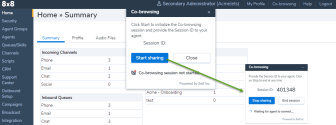Get remote customer assistance
8x8 Contact Center Co-browsing allows customer support agents to assist customers remotely via a shared browser. With Co-browsing, 8x8 Contact Center administrators can empower a website or any browser-based application, and offer live, hands-on assistance to customers. A customer in need of assistance must initiate the remote session, generate a unique session code, communicate it to an agent via phone or chat. The agent then uses the code to establish a remote session. Co-browsing session co-exists with a call or a chat for communicating the session code.
Features
- Visual, real-time web page assistance: Monitor and assist customers in real time through browser instance shared by the customer.
- Mouse tracking: As a customer, easily follow along by viewing the agent’s mouse location and movement.
- Platform details: Access information about the customer’s platform.
- Sub-domain support: The Co-browsing session continues working if the user navigates to a site that is hosted in a sub-domain, assuming that Co-browsing snippet is also included on that new sub-domain.
- Form co-filling: Co-fill forms on websites.
- Customer privacy and security: During a Co-browsing session, if the customer is filling a form and entering sensitive information such as SSN in a form, it can be encrypted and hidden from the agent.
- Highlighting: Agents can highlight content on web pages and call out information to customers during Co-browsing. Highlight key elements on the page with drawing tools.
- Auto-fit: Agents can automatically scale the browser view to fit customer's view settings. If the customer's screen is bigger than the agent during a Co-browsing session, agents will have to scroll constantly. With the ability to auto-fit, agents can enable “Auto-fit” to automatically scale the view to fit agent's view settings or manually increment/decrement the zoom level to the desired value.
- Privilege control: You can control the extent of remote help agents can offer using Co-browsing mode. It varies from a basic view only mode to complete control of the browser instance. Take control of the customer’s screen, with their permission.
Limitations
- Co-browsing only works in HTTP secure web pages.
- Adobe Flash components, including videos, and Java applets are not supported.
- Anything that is external to the current page is not supported. This includes the file browser window that is open when selecting a file to be uploaded.
- WYSIWIG editors (AceEditor, CodeMirrorEditor, CKEditor, tinymceEditor) are not supported.
- Native tool tips are not visible between the two parties.
- Mouse hover texts do not show in the Agent side.
- Web pages with iframes with different domains are not supported.
- If the web pages open new browser window and the content has Co-browsing, this new window replaces the content in the Agent side.
Supported browsers
See the system requirements for co-browsing supported browsers.
The following example demonstrates how a given website can be empowered with 8x8 Co-browsing.
Let us review an example of a travel company website visited by customers wanting to book their dream vacations. The website offers many travel packages and options to choose from. It requires customers to identify themselves by filling in a form. If a customer traversing through this website seeks hands-on assistance, he can initiate a remote session with a customer support agent in couple of clicks. Click on a help link on the web page to generate a code. Communicate this code to the representative. The representative uses this code to establish a two-way hands on Co-browsing session.
Co-browsing modes
By setting up a Co-browsing mode, administrators can control the extent to which agents can assist customers remotely. Co-browsing can be enabled in one of the following modes via code snippet. If you do not provide a mode in the code snippet, full-control is the default mode:
- full-control (default): In this mode, agents have full control of the customer's browser session, including synchronized navigation and the ability to highlight and co-fill a form on the web page. The agent's cursor movements and mouse clicks are in sync with the customer, and vice versa. This is the default mode. If you do not provide a mode in the code snippet, full-control is the default mode.
- partial-control: In this mode, agents can highlight and control the browser navigation, but do not have the privileges to fill any forms on the Co-browsed page. All HTML form elements are disabled on the agent side, alerting agents with the message "Forms cannot be edited on the agent side".
- no-control: This is a view-only mode. Agents can observe the customer’s navigation, highlight, and offer guidance.
Notes:
-The highlighter works in all modes.
-In the full-control and partial-control modes, we cannot prevent agents from controlling form elements that are not native to the browser, such HTML drop-down.
Co-browsing in 8x8 Configuration Manager offers 8x8 Contact Center customers using 8x8 Configuration Manager to seek hands-on assistance from 8x8 customer support or deployment team. Let us assume you are on a phone call with 8x8 customer support agent seeking assistance for configuring your tenant.
To initiate a Co-browsing session from 8x8 Configuration Manager:
- Log in to 8x8 Configuration Manager.
- From the header bar, click on Co-browsing link.
- In the pop-up window, click Start sharing to generate a code that helps you initiate a secure connection with the customer support agent.

- Communicate the code you just generated to the agent.
The agent, on the other hand, selects Co-browsing option from the 8x8 Agent Console menu. This triggers a new browser window prompting for the code. Enter the code received from the customer to initiate Co-browsing. The agent can view the 8x8 Configuration Manager session open by customer, co-browse, and observe the mouse movements and events of customer or offer hands-on assistance if needed. The session also respects the browser size set by the customer. Both parties can observe each other's mouse movements and events.
See how you can enable Co-browsing via chat as an administrator in 8x8 Configuration Manager.